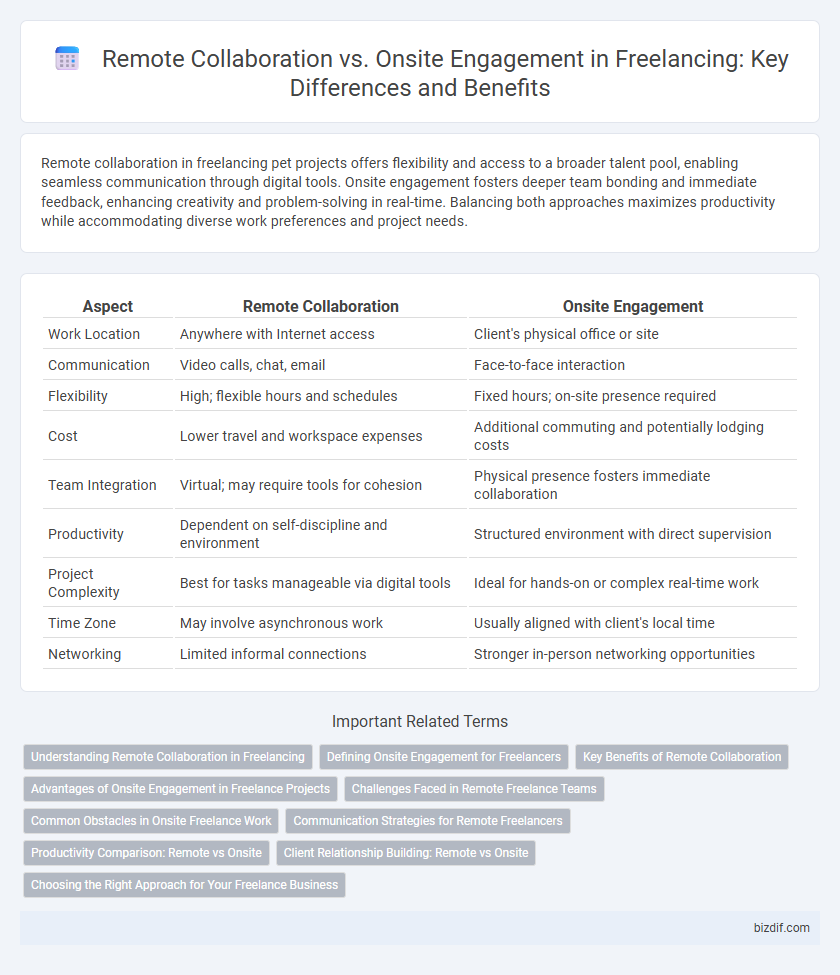Remote collaboration in freelancing pet projects offers flexibility and access to a broader talent pool, enabling seamless communication through digital tools. Onsite engagement fosters deeper team bonding and immediate feedback, enhancing creativity and problem-solving in real-time. Balancing both approaches maximizes productivity while accommodating diverse work preferences and project needs.
Table of Comparison
| Aspect | Remote Collaboration | Onsite Engagement |
|---|---|---|
| Work Location | Anywhere with Internet access | Client's physical office or site |
| Communication | Video calls, chat, email | Face-to-face interaction |
| Flexibility | High; flexible hours and schedules | Fixed hours; on-site presence required |
| Cost | Lower travel and workspace expenses | Additional commuting and potentially lodging costs |
| Team Integration | Virtual; may require tools for cohesion | Physical presence fosters immediate collaboration |
| Productivity | Dependent on self-discipline and environment | Structured environment with direct supervision |
| Project Complexity | Best for tasks manageable via digital tools | Ideal for hands-on or complex real-time work |
| Time Zone | May involve asynchronous work | Usually aligned with client's local time |
| Networking | Limited informal connections | Stronger in-person networking opportunities |
Understanding Remote Collaboration in Freelancing
Remote collaboration in freelancing leverages cloud-based tools such as Slack, Trello, and Zoom to streamline communication and project management across diverse time zones. This mode enhances flexibility, enabling freelancers to work with global clients without geographic constraints while fostering asynchronous workflows that boost productivity. Mastery of remote collaboration skills like digital communication etiquette and virtual teamwork is essential for delivering high-quality results in the competitive freelancing marketplace.
Defining Onsite Engagement for Freelancers
Onsite engagement for freelancers involves working physically at the client's location, enabling direct interaction with teams and immediate access to resources. This model fosters real-time communication, stronger relationship building, and deeper immersion in company culture. It requires flexibility in travel and scheduling but often results in enhanced project alignment and quicker issue resolution.
Key Benefits of Remote Collaboration
Remote collaboration enhances flexibility by allowing freelancers to work from any location, reducing commuting time and increasing productivity. It also enables access to a global talent pool, fostering diverse skill sets and innovation. Real-time communication tools streamline workflows and support seamless project management across distributed teams.
Advantages of Onsite Engagement in Freelance Projects
Onsite engagement in freelance projects offers direct access to client resources, enabling faster decision-making and immediate problem-solving, which significantly boosts project efficiency. It facilitates stronger team cohesion and clearer communication through face-to-face interactions, reducing misunderstandings and enhancing collaborative creativity. Clients and freelancers benefit from real-time feedback and a shared work environment, fostering trust and alignment that leads to higher-quality deliverables.
Challenges Faced in Remote Freelance Teams
Remote freelance teams often face challenges such as communication barriers due to time zone differences and lack of face-to-face interaction, which can lead to misunderstandings and delays. Ensuring consistent productivity and accountability is difficult without physical supervision, and varying internet connectivity further hampers seamless collaboration. Overcoming these obstacles requires effective digital tools and strong self-discipline to maintain project momentum and team cohesion.
Common Obstacles in Onsite Freelance Work
Onsite freelance work often faces common obstacles such as limited flexibility in work hours, increased commuting time, and potential interruptions from office dynamics that can reduce productivity. Physical presence requirements may also lead to higher costs and logistical challenges for both freelancers and clients. Access to diverse talent pools is restricted compared to remote collaboration, which leverages technology to bridge geographic distances effectively.
Communication Strategies for Remote Freelancers
Effective communication strategies for remote freelancers include leveraging digital tools such as Slack, Zoom, and Trello to facilitate real-time collaboration and project management. Establishing clear expectations through detailed briefs, regular check-ins, and transparent feedback loops reduces misunderstandings and enhances productivity. Prioritizing asynchronous communication allows freelancers to work flexibly across time zones while maintaining consistent engagement with clients and team members.
Productivity Comparison: Remote vs Onsite
Remote collaboration often enhances productivity by reducing commute time and enabling flexible work hours, leading to increased focus and task completion rates. Onsite engagement facilitates immediate communication and hands-on supervision, which can accelerate problem-solving and team cohesion. Studies show remote workers report a 13% increase in productivity, while onsite teams benefit from real-time interactions that improve project turnaround times.
Client Relationship Building: Remote vs Onsite
Remote collaboration in freelancing leverages digital tools to maintain constant communication, enabling frequent updates and immediate feedback, which fosters trust and transparency with clients. Onsite engagement allows for face-to-face interactions that build stronger emotional connections and facilitate non-verbal cues, enhancing mutual understanding and rapport. Both approaches require proactive communication strategies to establish and sustain long-term client relationships in a competitive freelancing market.
Choosing the Right Approach for Your Freelance Business
Remote collaboration offers freelancers access to a global talent pool and flexible work hours, enhancing productivity and reducing overhead costs. Onsite engagement fosters direct communication and stronger client relationships, which can lead to higher trust and immediate feedback. Evaluating project requirements, client preferences, and your workflow style is essential to determine the optimal approach for your freelance business success.
Remote collaboration vs Onsite engagement Infographic

 bizdif.com
bizdif.com